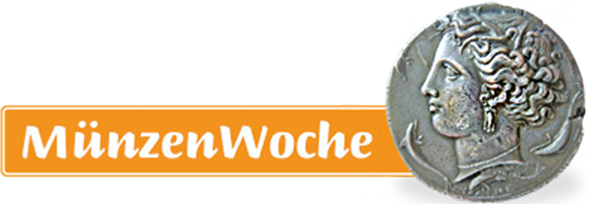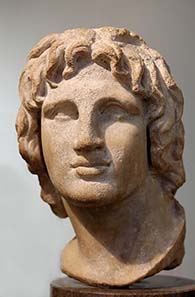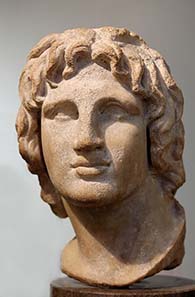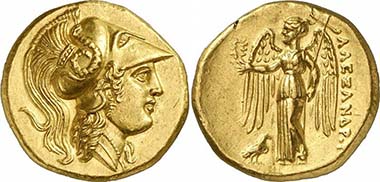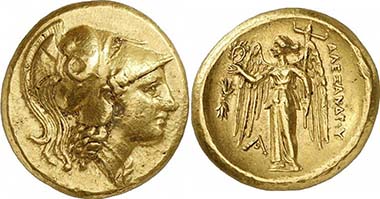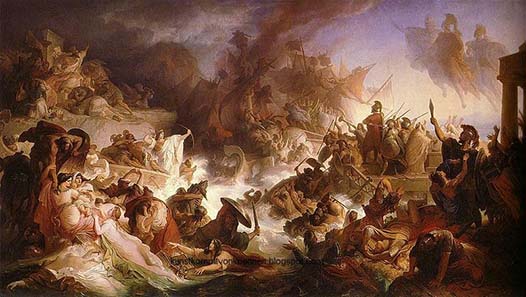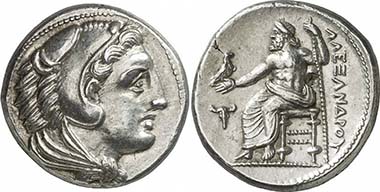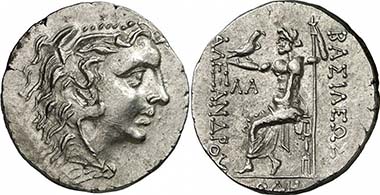The coins of Alexander III the Great of Macedonia
Whereas the owls of Athens were the most important currency of the Greeks in Classical times, the Hellenistic era is characterized by the coins of Alexander the Great. He had a vast number of coins manufactured out of necessity to utilize the looted Persian treasures for funding his campaign. Alexander could only field them as coins. They served to remunerate the soldiers, to pay for supplies and as presents for important cities and persons in mainland Greece.
Alexander the Great. Bust in the British Museum. Photograph: Jastrow / Wikipedia.
At the beginning of Alexander’s reign, however, nothing pointed at the Macedonian King having such enormous treasures at his disposal that his coins could become standard currency for centuries. On the contrary, when Alexander took office, he inherited only 500 talents debts. Thanks to the big expenses for the various campaigns his father Philipp II had to conduct to enforce his claim as hegemon of Greece, the treasure chambers were empty. There were only 60 talents cash left plus a few gold and silver utensils that could be melted and coined in a time of need. Alexander was not able to live it up on that. When the young King took office, he therefore had to borrow 800 talents to provide the financial means necessary to secure the borders of his empire against the invading Thracians.
After the campaign and its rich booty the precarious financial situation improved slightly but the preparations of the campaign against the Persians tore a hole in the Royal coffer again. When Alexander set out for Asia Minor, 70 talents silver in the treasure chamber were pitted against 200 talents debts. In addition, the army had supplies for 30 days available. Hence, Alexander’s campaign based not on means but on boldness. He needed a quick victory to get his hands on the money necessary for continuing.
Alexander the Victor. Mosaic from Pompeii. Photograph: Ruthven / Wikipedia
We all know the sweeping victory of the Greek troops. Alexander defeated the Persian satraps already in May 334 at the Granicus River and gained the money that was essential for continuing his military efforts. The victories in Asia Minor alone brought the King more booty he had ever seen in cash in his treasure chamber. Out of the booty from the seizure of Sardes in 333, for example, he was able to pay all his remaining debts at once. A year later, Alexander obtained in Damascus more than 2,600 talents, i.e. more than 13 times his debts when he set off. It was the Persian mother country that restructured Alexander for the rest of his life. Susa brought 50,000 talents, Persepolis 120,000 and Ecbatana 180,000. If Alexander had coined the last mentioned sum (180,000 talents of silver) he, at least theoretically, would have produced – 1 talent equating 6,000 drachms – 1,080,000,000 drachms or 270,000,000 tetradrachms, a number beyond imagination.
But the King was in need of such sums. His troops were expensive. According to modern estimation, one day of campaigning with his army cost him 20 talents. That would have been 7,500 talents per year – a utopian sum at the beginning of his reign. Of course, the King did not pay his soldiers on a daily basis. The only received their salary once a month or when they left the army to return home. The need of coined money nevertheless was great. The total cost of Alexander’s campaign are estimated today at 80,000 talents, i.e. more than 1300 times the sum his treasure chamber contained when he accessed office but, by this time, a rather small sum for the victorious King. After all, with the booty from Ecbatana alone the war absolutely paid off.
The exact time of Alexander introducing his new coins is under dispute amongst researchers. Some think of a date immediately after his accession, some favour a date when Alexander had bigger sums at his disposal for the first time, meaning the time following the seizure of Tarsus in 333. Be that as it may, Alexander created a currency system that was about to be valid for centuries.
Alexander III. Gold stater, Salamis, during his lifetime. From auction Gorny & Mosch 185 (2010), 84.
He had gold staters minted that showed the head of the goddess Athena of the obverse and a Nike holding a stylis on the reverse. Peculiar is Athena’s helmet which is of Corinthian type – a shape that was never common in Macedonia and even in Greece was long out of date at the time of the campaign. To Alexander, however, that helmet had a special meaning. He characterized the goddess as patroness of Corinth, home of the League of Corinth. Both he and his father before him had invested much money and effort to make the members of the League of Corinth appointed them commander. They decided to conduct a retaliation campaign against the Persians with Philippos and later Alexander as leader. The choice to depict Athena on the coins’ reverse comes as no surprise, then. On the one hand, she was regarded the one that inspired in war with cunning schemes and thoughts to beat the enemy, on the other she was the goddess with the biggest losses in the Persian campaign more than 100 years ago. It had been her city the Persians had burnt to the ground. Her temple had burst into flames. She of all deities had an interest in aiding Alexander in his retaliation campaign. Hence, it was only logical to show her on the obverse of the gold staters. She was the goddess Alexander thanked after the Battle at the Granicus River in May 334: he dedicated a part of the booty to her, 300 full Persian suits of armour. They were inscribed with the words “Alexander, son of Philipp and all the Greeks except the Lacedaemonians from the Barbarians who dwell in Asia.” (Plutarch, Alexander 16, 8)
Alexander III. Gold double stater, during his lifetime, Aigai. From auction Gorny & Mosch 185 (2010), 82.
It much more difficult to read the coins’ reverse. Nike, goddess of victory, holds a wreath in one hand and a stylis in the other. That mast with a crossbar was situated at an ancient ship’s stern near the aphlaston, a decoration of the ship. It was a kind of ship’s palladion, a substitute for the divine images that were cumbersome and hard to transport. On the crossbar was often the name of a deity inscribed which was evoked in times of emergency. There, the sailors sacrificed prior to departure and on arrival, before going into battle and in bad weather. Because the mast was situated very near the aphlaston and easily removable, it – like the aphlaston – became a typical trophy of a naval battle. Nike as a single figure, holding a wreath, would be easy to explain on Alexander’s coinage: she would refer to victories of the past and – hopefully – the future. The typically maritime victory trophy, however, puzzles the scientists. After all, Alexander’s campaign suffered from the lack of a fleet which could have convoyed the operations by land. Plus, there is no true naval victory in the entire history of Alexander’s campaigns. So, what naval victory does the coin image refer to? About that – yet again – the researchers are still in disagreement. One interprets the passage from Europe to Asia, which of course was made by ship, as “naval victory”. That, however, falls short. Alexander simply did not need to boast about such marginal notes as victories. There must be another reasonable explanation. Does it have to do with a victory of Alexander anyway?
Wilhelm von Kaulbach (1805-1874), The naval Battle of Salamis in the Maximilianeum, the Bavarian Landtag.
Greek history witnessed one big and symbolic naval victory over the Persians – the Battle of Salamis. The united forces of the Greek city-states had defeated the Persian emperor there. Why not evoke that victory on Alexander’s coins as good omen for the new campaign of the League of Corinth? That would fit the obverse since Salamis was the first big victory of the Greeks after Athens had been destroyed. Plus, the Greeks believed that it had been gained with the support of Athena dictating Themistocles how to outsmart the Persians. Hence, the gold staters allude to the campaign against the Persians in 480 B. C. They refer to the fist Greek victory and evoke a new triumph.
Alexander III. Tetradrachm, during his lifetime, Macedonia. From auction Gorny & Mosch 186 (2010), 1252.
Alexander chose a new coin type for his tetradrachms and drachms as well: he had them produced with an image of Herakles on the obverse and one of Zeus on the reverse. There were possibly three reasons why he chose to show Herakles on the obverse of his most important denomination. First, the beardless Herakles had already been present on the coins of his father, albeit rarely and on the smaller denominations only. By tradition, the Argead dynasty, that ruled in Macedonia and which Alexander was a member of, regarded Herakles as progenitor of its family. That lineage proved the Argead dynasty belonging to the Hellenes. The second reason for Alexander’s choice was the personal reverence he himself showed to Herakles. And, thirdly, Herakles was seen as a fighting hero and saviour that aided against the evil. Alexander, who had set off to protect the Greeks against the Barbarians and to free them, considered him a perfect symbolic figure for his own scheme.
In many descriptions of those coins it reads that the depiction of Herakles in reality represents Alexander. That was surely not intended at the beginning of the coin production. It did not cross the Greek and Macedonian mind yet to depict a living person on their coins. Only the “barbaric” Persians and the satraps they had installed in Asia Minor did that. In the first stage of his reign, Alexander had not actually proved that he outclassed any ordinary Macedonian ruler. It was only after Alexander’s death, when the tetradrachms had become a universally valid currency, that the die cutters shaped the face of Herakles similar to Alexander’s.
Zeus who Philippos II have had depicted on the obverse of his tetradrachms is moved to the reverse under Alexander. It is tempting to interpret that as a son paying back his overpowering father. But let us stick to the facts. One thing is clear: Zeus, Herakles, Athena, those were precisely the deities that programmatically protected and assisted in the campaign against the Persians. To them Alexander sacrificed on his departure from Europe and his arrival in Asia. At the location of each sacrifice he had an altar set up.
When looking at the inscriptions of the various tetradrachms and drachms it is striking that Alexander sometimes – but certainly not every time – is called BASILEUS, King. In democratic Greece, that title still was not “decent”. Alexander therefore had no intention to name the title on his coins that were designed for the entire Greek world. Only at the end of his reign the mints in Babylonia, Southern Asia Minor and Phoenicia, where the designation King did not evoke any negative associations as on the mainland, began to manufacture tetradrachms and drachms that stated the title. Macedonia followed probably in 323, perhaps even a little earlier. Because Alexander died soon later, he could not issue an edict anymore with any explicit statement for all mints whether or not to name his title on coins. Hence, it was left to the mints how to proceed in that matter.
Odessos (Thrace). Tetradrachm, 125-70 B. C. The head of Herakles bears the facial features of Mithradates III. From auction Gorny & Mosch 186 (2010), 1285.
Alexander’s tetradrachms flooded his newly created vast empire. Thanks to their omnipresence they gained great popularity in the Greek as well as the non-Greek world and were readily accepted everywhere. For that reason, they continued to be minted long after the death of Alexander. They were used primarily in the international trade. In a manner of speaking, many cities had two currencies: there were coins minted with local symbols for the inner-city trade; for the trade with cities further away tetradrachms were made according to the Alexander type. Until the 1st cent. B. C., coins following that model circulated in the entire ancient world. No other single human being has left its marks on numismatics like the great Macedonian King.





